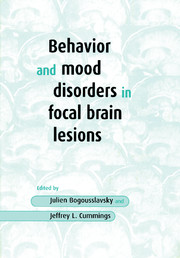Book contents
- Frontmatter
- Dedication
- Contents
- List of contributors
- Preface
- Acknowledgments
- 1 Emotional consequences of focal brain lesions: an overview
- 2 The evaluation of mood and behavior in patients with focal brain lesions
- 3 Methodological issues in studying secondary mood disorders
- 4 Emotional behavior in acute brain lesions
- 5 Depression and lesion location in stroke
- 6 Mood and behavior in disorders of the basal ganglia
- 7 Mania and manic-like disorders
- 8 Behavioral and emotional changes after focal frontal lobe damage
- 9 Disorders of motivation
- 10 Thalamic behavioral syndromes
- 11 Obsessive-compulsive disorders in association with focal brain lesions
- 12 Emotional dysprosody and similar dysfunctions
- 13 Temporal lobe behavioral syndromes
- 14 Neural correlates of violent behavior
- 15 Focal lesions and psychosis
- 16 Alterations in sexual behavior following focal brain injury
- 17 Anosognosia
- 18 Acute confusional states and delirium
- Index
17 - Anosognosia
Published online by Cambridge University Press: 05 August 2016
- Frontmatter
- Dedication
- Contents
- List of contributors
- Preface
- Acknowledgments
- 1 Emotional consequences of focal brain lesions: an overview
- 2 The evaluation of mood and behavior in patients with focal brain lesions
- 3 Methodological issues in studying secondary mood disorders
- 4 Emotional behavior in acute brain lesions
- 5 Depression and lesion location in stroke
- 6 Mood and behavior in disorders of the basal ganglia
- 7 Mania and manic-like disorders
- 8 Behavioral and emotional changes after focal frontal lobe damage
- 9 Disorders of motivation
- 10 Thalamic behavioral syndromes
- 11 Obsessive-compulsive disorders in association with focal brain lesions
- 12 Emotional dysprosody and similar dysfunctions
- 13 Temporal lobe behavioral syndromes
- 14 Neural correlates of violent behavior
- 15 Focal lesions and psychosis
- 16 Alterations in sexual behavior following focal brain injury
- 17 Anosognosia
- 18 Acute confusional states and delirium
- Index
Summary
Introduction
Anosognosia refers to the lack of awareness, misbelief, or explicit denial of their illness that patients may show following brain damage or dysfunction. Anosognosia may involve a variety of neurological impairment of sensorimotor, visual, cognitive or behavioral functions, as well as non-neurological diseases. The term was coined by Joseph Babinski in 1914 when he reported at the meeting of the Society of Neurology of Paris on two patients who had left hemiplegia after a right hemisphere stroke but ‘were ignorant or seemed ignorant of the paralysis which affected them’ (Babinski, 1914). Babinski emphasized the absence of confusion and major intellectual disturbance. During the discussion that followed his report, he and the neurologists who attended the meeting speculated on more than a halfdozen possible mechanisms to explain anosognosia. Babinski himself considered a deliberate protection of self-esteem and self-appearance as plausible but unlikely, and he pointed to the special role of right hemisphere lesions. He also stressed the possible role of a severe sensory loss. Dejerine and Souques agreed with the latter, while Ballet pondered on an underlying disorder of anterograde memory. Meige argued for a selective functional motor amnesia superimposed on hemiplegia. Claude raised the issue of a loss of representation of the affected limbs and, in addition, related anosognosia to cases with unilateral apraxia and topoanesthesia that would nowadays suggest some sort of interhemispheric disconnection syndrome. Finally, after a second report of Babinski in 1918, Pierre Marie put forward the role of spatial neglect. More than 80 years later, explanations for anosognosia appear not to have gone far beyond the above discussion; many of these speculations are still in place.
Anosognosia had actually been observed long before Babinski's report. While Seneca made mention of a woman who ‘did not know that she was blind’ (cited in Bisiach and Geminiani, 1991), and Montaigne (1588) discussed a similar disorder in a nobleman, unawareness of blindness was first described as a neurological condition in 1885 by Von Monakow in two patients with bilateral posterior brain damage. Others (e.g., Dejerine and Viallet, 1893; Rossplimo, 1896), described similar cases a few years later. However, Anton (1898) first theorized about the mechanisms of these disorders with respect to perceptual awareness. He described a patient who denied her cortical blindness, as well as two other patients who appeared unaware of their receptive aphasia and cortical deafness (Anton, 1898).
- Type
- Chapter
- Information
- Behavior and Mood Disorders in Focal Brain Lesions , pp. 465 - 519Publisher: Cambridge University PressPrint publication year: 2000
- 19
- Cited by

